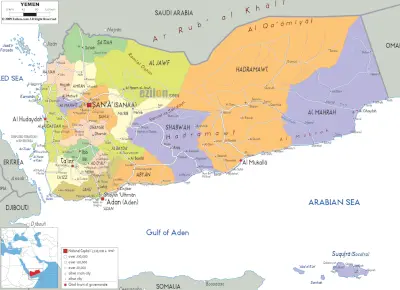Yemen's Market Overview
Yemen is located in southwest Asia and south of the Arabian Peninsula, the capital of which is the beautiful city of Sanaa. Estimates show that the revenue situation in Yemen in 2019 grew by about 12 percent. Trade balances in Yemen are about 14% higher than before, and growth in this area is considered acceptable. Sanaa is one of the most important cities in Yemen, which has grown a lot in terms of work as beautiful city in the field of tourism. Britain conquered Yemen in 1943 but gained independence in 1967. The present-day Republic of Yemen was established in 1990 in Yemen. The people of Yemen have no interest in extravagance, and this can be seen in all the cities of Yemen. The flag of Yemen is tied to the history of this country.
Where is Yemen and how is situation of capital turnover?

Yemen is located in the southwestern part of the Arabian Peninsula in Western Asia. It is strategically positioned at the southern entrance of the Red Sea, which is an important international shipping route connecting Europe, Asia, and Africa. Yemen's location has historically made it a significant hub for trade and capital circulation. Its proximity to major shipping lanes has facilitated maritime trade, including the movement of goods and capital between different regions. Yemen has several important ports, including the Port of Aden, Port of Hodeidah, and Port of Mukalla. These ports serve as crucial gateways for imports, exports, and transshipment of goods, enhancing capital circulation and trade within the country and with other nations.
However, it's important to note that Yemen has been facing significant economic challenges in recent years due to ongoing conflicts and political instability. These challenges have severely impacted the state of capital circulation and overall economic activity in the country. Temperatures in the mountains vary with altitude and season, with an average of 16°C and frosty winter nights in the higher mountains. The Tihama coastal strip, by contrast, is always hot and is very humid during the rainy season, a climate similar to that across the Red Sea, in Eritrea and Somalia. The eastern desert has a dry climate, with heavy but sporadic rains and frosty nights.
Where is Yemen and how is situation of capital turnover?, Read More ...
Add your import and export orders to this list
Warning: Undefined variable $formTitle in /home/anbar/domains/anbar.asia/anbar/inc/html/desktop/orderform.php on line 10
Warning: Undefined variable $marketName in /home/anbar/domains/anbar.asia/anbar/inc/html/desktop/orderform.php on line 12
Warning: Undefined variable $location in /home/anbar/domains/anbar.asia/anbar/inc/html/desktop/orderform.php on line 12
If you want to trade in the , please join in Anbar Asia. Your order will be shown here, so the traders of contact you

How is the export and import system of Yemen?

Yemen's main exports traditionally include crude oil, liquefied natural gas (LNG), refined petroleum products, fish, and agricultural products such as coffee, honey, and fruits. The primary export ports in Yemen are Aden, Hodeidah, and Mukalla. These ports play a crucial role in facilitating the export of goods and commodities. The conflict in Yemen has severely impacted the export sector. Infrastructure damage, including to ports and transportation networks, has hindered the country's ability to export goods effectively. Additionally, restrictions, blockades, and security concerns have further disrupted trade activities.
Yemen relies heavily on imports to meet its domestic needs. Key imported goods include food items, fuel, machinery, vehicles, pharmaceuticals, and various consumer goods.The major ports involved in Yemen's import activities are Aden, Hodeidah, and Mukalla. These ports are crucial entry points for goods coming into the country. Importing goods into Yemen has been significantly affected by the conflict and the resulting humanitarian crisis. The conflict has led to increased restrictions, delays, and disruptions in supply chains, making it difficult to bring essential goods into the country. Importers must navigate security concerns, bureaucratic hurdles, and logistical challenges.
How is the export and import system of Yemen?, Read More ...
![]() Yemen Natural Stones Market
Yemen Natural Stones Market![]() Yemen Minerals Market
Yemen Minerals Market![]() Yemen Petroleum Market
Yemen Petroleum Market![]() Yemen Gemstones Market
Yemen Gemstones Market![]() Yemen Construction Materials Market
Yemen Construction Materials Market![]() Yemen Chemicals Market
Yemen Chemicals Market![]() Yemen Metals Market
Yemen Metals Market![]() Yemen Petrochemicals Market
Yemen Petrochemicals Market![]() Yemen Real estates Market
Yemen Real estates Market![]() Yemen Food Market
Yemen Food Market![]() Yemen Crops Market
Yemen Crops Market![]() Yemen art and craft Market
Yemen art and craft Market
Global ranking in all areas of Yemen

The conflict has caused a significant contraction in Yemen's GDP, as infrastructure damage, disruptions in production, and decreased investment have hampered economic growth. Yemen has experienced high inflation rates due to disruptions in the supply chain, reduced domestic production, and increased reliance on imports. The conflict has led to widespread job losses and limited employment opportunities, contributing to high unemployment rates and increased poverty levels. Yemen faces a severe humanitarian crisis, with millions of people in need of humanitarian assistance, including food, water, and healthcare. This crisis has strained the country's resources and further weakened its economic resilience.
The conflict has disrupted trade routes, both within Yemen and with neighboring countries. Blockades, security concerns, and damaged infrastructure have hindered the movement of goods and affected the overall commercial activities in the country. The conflict and political instability have deterred foreign direct investment in Yemen. The risks associated with the conflict, including security concerns and uncertain political environment, have made international businesses cautious about investing in the country. The importation of humanitarian aid and essential goods has been a critical aspect of commercial activities in Yemen. International organizations and relief agencies play a crucial role in facilitating the importation and distribution of humanitarian supplies.
Global ranking in all areas of Yemen, Read More ...
The capital and major cities of Yemen

Aden is a port city located in the southern part of Yemen. It has a strategic location along the Gulf of Aden and has historically been an important hub for trade and commerce. Taiz is a city in southwestern Yemen, situated in the Yemeni Highlands. It is known for its historical significance, architectural heritage, and cultural traditions. Al Hudaydah, also known as Hodeidah, is a port city located on Yemen's Red Sea coast. It serves as a major gateway for imports and exports and has been a focal point in the ongoing conflict in Yemen.
The return of the Indian Ocean to the Red Sea is also followed in certain periods. The Sabaeans ruled the region for about nine centuries. This government was overthrown by the Homerians. The Hamirian rule lasted from 515 BC to 531 BC and was extinct by the Abyssinians. In 1750, the land became part of the Ottoman Empire and became independent.
The capital and major cities of Yemen, Read More ...
Yemen dependent countries and regions

Saudi Arabia has played a prominent role in the Yemeni conflict and has been leading a military coalition supporting the internationally recognized government of Yemen. It has provided financial aid, military support, and humanitarian assistance to Yemen. The UAE has been a key partner of Saudi Arabia in the coalition supporting the Yemeni government. It has contributed military forces and humanitarian aid to Yemen. The United States has been involved in Yemen through various means, including providing military support to the Saudi-led coalition, supporting peace negotiations, and providing humanitarian assistance to address the humanitarian crisis.
The United Nations has been actively engaged in Yemen, working to facilitate peace negotiations, coordinate humanitarian aid, and support the Yemeni people. The UN agencies, such as the United Nations Development Programme (UNDP) and the United Nations Children's Fund (UNICEF), have been providing assistance in various sectors. The EU has provided humanitarian aid and assistance to Yemen, focusing on addressing the humanitarian crisis, supporting development projects, and promoting peace and stability in the region. Other GCC countries, including Kuwait, Qatar, Bahrain, and Oman, have also been involved in providing aid and support to Yemen, both through bilateral initiatives and collective efforts.
Yemen dependent countries and regions, Read More ...
Constitution and laws in Yemen

Yemen's legal framework is primarily governed by its constitution. The current constitution of Yemen was adopted in 2001 and outlines the fundamental principles, structure of government, and rights of individuals in the country. Yemen is an Islamic country, and Islamic law, known as Sharia, is an important source of legislation. Sharia principles influence various aspects of personal, family, and criminal law in Yemen. Yemen has a civil law system based on the French legal system. It includes statutes and regulations that cover various areas of civil, commercial, and administrative law.
Family matters in Yemen are primarily regulated by Islamic law. Issues such as marriage, divorce, child custody, and inheritance are governed by Sharia principles. Criminal offenses in Yemen are addressed by the Yemeni Penal Code. The penal code specifies different crimes and their corresponding punishments. Sharia principles also influence certain aspects of criminal law. The labor rights and employment relationships in Yemen are regulated by the Yemeni Labor Law. It covers areas such as employment contracts, working conditions, wages, hours of work, leave entitlements, and termination of employment.
Constitution and laws in Yemen, Read More ...

















